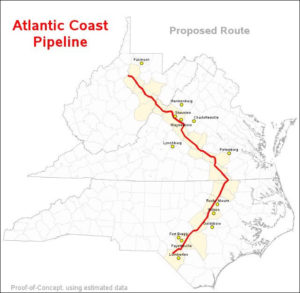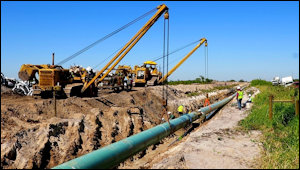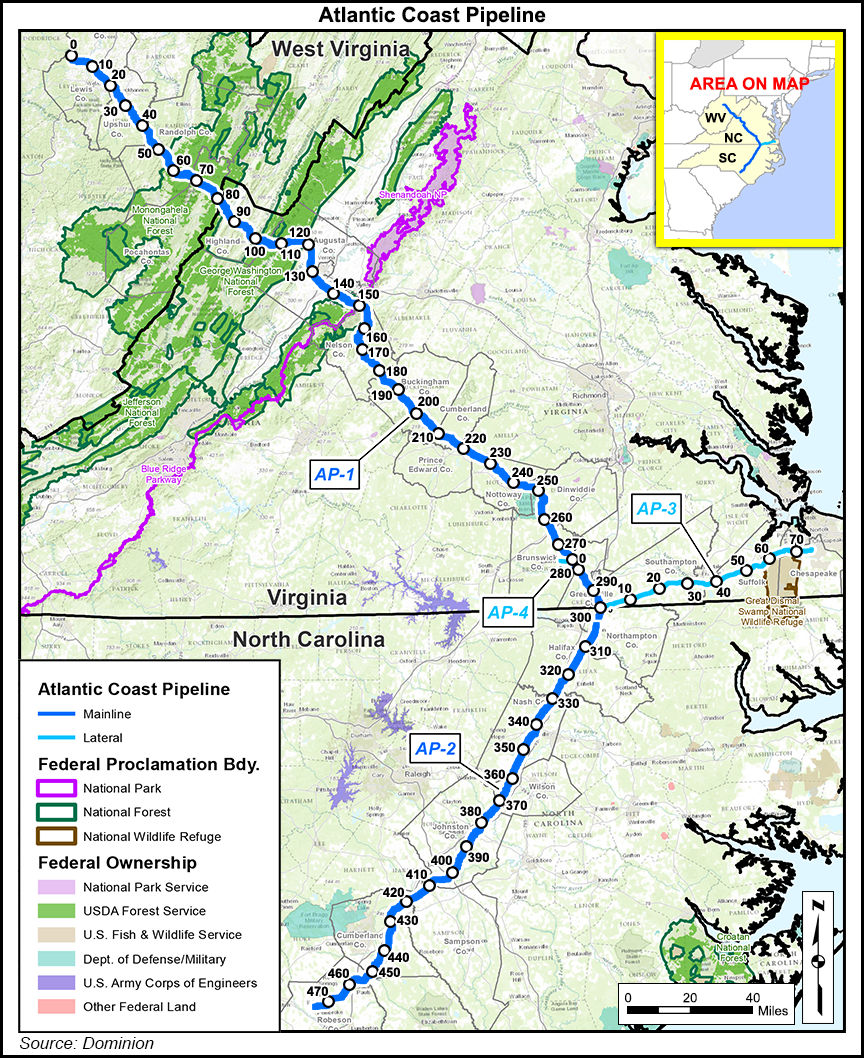Virginia has its very own snail darter — the Roanoke logperch, a threatened species of fish, the existence of which could delay or even obstruct a multibillion-dollar infrastructure project.
The snail darter became a cause celebre for endangered species in 1973 when concerns arose that the habitat of the endangered fish would be obliterated by construction of the Tellico Dam on the Little Tennessee River. Although the dam ultimately was built, the controversy over the snail darter’s fate held up the project through years of legal appeals and eventually required a literal act of Congress to override a U.S. Supreme Court ruling.
The Roanoke logperch is one of six endangered or threatened species whose habitat will be crossed by the Atlantic Coast Pipeline (ACP), according to the Richmond Times-Dispatch. The ACP won’t obliterate the habitats of the logperch, the Indiana bat, the Northern long-eared bat, the Madison Cave isopod, the rusty patched bumblebee, or the clubshell mussel in the way that the Tellico Dam did the homeland of the snail darter. But the pipeline will cross these species’ habitats, subjecting them to additional stress, and perhaps killing some individuals. A federal appeals court ruled that the U.S. Fish and Wildlife Service had set unacceptably vague criteria for monitoring and complying with the Endangered Species Act. Pipeline foes regard the threat to the species as sufficient grounds to shut down construction.
A question unasked by the media in coverage of the ruling is just how threatened are these species? What impact might pipeline construction have on their habitat? Could the pipeline precipitate their extinction or will the effect be marginal? But alert reader D.J. Rippert raised the issue in a comment to an earlier article on the topic. According to the International Union for Conservation of Nature (IUCM) Red List, he wrote, “the Roanoke Logperch is one notch above endangered. The key question is whether the pipeline would push it from vulnerable to endangered.”
Good point, Don. Let’s see what IUCM has to say about the six species in question. But first some nomenclature: A “vulnerable” species is one that is likely to become endangered unless the circumstances threatening its survival and reproduction improve. The next steps up the ladder towards extinction are a “endangered” and then “critically endangered.” The term “threatened” applies to any species “likely to become an endangered species within the foreseeable future throughout all or a significant portion of its range.”
Roanoke logperch. Precina Rex is listed as “vulnerable.” Its range extends through the upper Roanoke, upper Dan, and upper Chowan river systems. Eight populations are separated by wide river gaps or dams. The fish resides in riffles, runs, and pools with sandy to boulder-strewn bottoms. Despite the ongoing threats of urbanization, industrial development, flood control projects, and agricultural runoff, the population is believed to be increasing. However, siltation from agricultural “and other human activities” remains a concern.
 Indiana bat. Myotis soldalis is listed as “near threatened.” The bat has an extensive range across the eastern United States but the range and population have shrunk in recent years. The most significant threats to the species are habitat loss, forest fragmentation, winter disturbance and environmental contaminants. Half the bats are believed to hibernate in Indiana (hence the name); other major population centers are located in Kentucky and Missouri. Virginia is a minor and peripheral part of the bat’s range.
Indiana bat. Myotis soldalis is listed as “near threatened.” The bat has an extensive range across the eastern United States but the range and population have shrunk in recent years. The most significant threats to the species are habitat loss, forest fragmentation, winter disturbance and environmental contaminants. Half the bats are believed to hibernate in Indiana (hence the name); other major population centers are located in Kentucky and Missouri. Virginia is a minor and peripheral part of the bat’s range.
 Madison cave isopod. Antrolana lira is classified as “vulnerable.” This tiny critter is an eyeless, unpigmented freshwater crustacean that lives in flooded limestone caves in the northern Shenandoah Valley, with documented population centers around Staunton and Harrisonburg. The ICUN database contains little information about the isopod. Contamination of underground water is the major threat to the creature’s habitat — definitely an issue in the karst terrain in Virginia mountain terrain.
Madison cave isopod. Antrolana lira is classified as “vulnerable.” This tiny critter is an eyeless, unpigmented freshwater crustacean that lives in flooded limestone caves in the northern Shenandoah Valley, with documented population centers around Staunton and Harrisonburg. The ICUN database contains little information about the isopod. Contamination of underground water is the major threat to the creature’s habitat — definitely an issue in the karst terrain in Virginia mountain terrain.
 Rusty patched bumble bee. IUCM does not have this species of bumble bee in its database. But Fish & Wildlife does refer to it as “endangered.” “Rusty patched bumble bees once occupied grasslands and tall grass prairies of the Upper Midwest and Northeast, but most grasslands and prairies have been lost, degraded, or fragmented by conversion to other uses,” states the endangered species website. The range has constricted to 13 states, of which Virginia is one, plus one Canadian province. The biggest threat comes from intensive farming and the use of pesticides.
Rusty patched bumble bee. IUCM does not have this species of bumble bee in its database. But Fish & Wildlife does refer to it as “endangered.” “Rusty patched bumble bees once occupied grasslands and tall grass prairies of the Upper Midwest and Northeast, but most grasslands and prairies have been lost, degraded, or fragmented by conversion to other uses,” states the endangered species website. The range has constricted to 13 states, of which Virginia is one, plus one Canadian province. The biggest threat comes from intensive farming and the use of pesticides.
Clubshell mussel. Also not included in the IUCM database, the clubshell mussel is described by Fish & Wildlife as an “endangered” species. The bivalve, which lives in small to medium rivers and streams, once was found from Michigan to Alabama, Illinois to West Virginia — Virginia does not warrant mention as part of its range — and now is relegated to “portions of only 13 streams.” The major threats listed are pollution from agricultural run-off, industrial wastes, and extensive impoundments for navigation, all compounded by competition with the Zebra mussel.
 Northern long-eared bat. The Northern long-eared bat does not appear in the IUCN’s red list but it is listed as “threatened” by Fish & Wildlife. The bat’s range extends throughout most of the Eastern U.S. and parts of Canada. Its population decline has been caused by the “white-nosed syndrome,” a fungal disease. The disease has spread to bats in Virginia.
Northern long-eared bat. The Northern long-eared bat does not appear in the IUCN’s red list but it is listed as “threatened” by Fish & Wildlife. The bat’s range extends throughout most of the Eastern U.S. and parts of Canada. Its population decline has been caused by the “white-nosed syndrome,” a fungal disease. The disease has spread to bats in Virginia.
Bacon’s bottom line: This is a superficial survey, and I welcome the input of anyone who has more detailed and authoritative knowledge. But it seems reasonable to draw several conclusions.
First, none of these species are “critically endangered.” Only two are listed as “endangered.” The other four are classified as “threatened” or “vulnerable.” Continue reading




 The Atlantic Coast Pipeline, originally estimated to cost about $5 billion to $5.5 billion, now is expected to cost between $6 billion and $6.5 billion. That estimate comes from CEO Lynn Good of Duke Energy, one of the pipeline’s four corporate partners, in a Tuesday earnings call, as reported by the
The Atlantic Coast Pipeline, originally estimated to cost about $5 billion to $5.5 billion, now is expected to cost between $6 billion and $6.5 billion. That estimate comes from CEO Lynn Good of Duke Energy, one of the pipeline’s four corporate partners, in a Tuesday earnings call, as reported by the 
 Yes, it’s a legitimate story when Dominion spend big bucks supporting grassroots groups that favor the Atlantic Coast Pipeline. Why isn’t it also a story when out-of-state billionaires underwrite pipeline foes?
Yes, it’s a legitimate story when Dominion spend big bucks supporting grassroots groups that favor the Atlantic Coast Pipeline. Why isn’t it also a story when out-of-state billionaires underwrite pipeline foes?


 While the proposed 605-mile Atlantic Coast Pipeline (ACP) would have temporary adverse impacts
While the proposed 605-mile Atlantic Coast Pipeline (ACP) would have temporary adverse impacts  As far as I’m concerned, the environmental regulatory process governing the proposed Atlantic Coast Pipeline and Mountain Valley Pipeline is incomprehensible. And that’s a bad thing. If only a handful of regulators, industry players and environmentalist activists can navigate the layers of bureaucracy and thicket of rules, the public is the loser.
As far as I’m concerned, the environmental regulatory process governing the proposed Atlantic Coast Pipeline and Mountain Valley Pipeline is incomprehensible. And that’s a bad thing. If only a handful of regulators, industry players and environmentalist activists can navigate the layers of bureaucracy and thicket of rules, the public is the loser.
